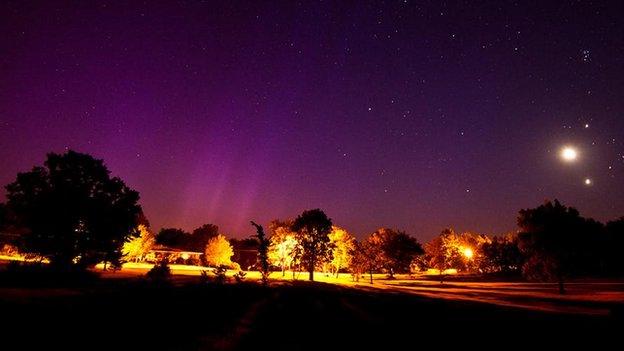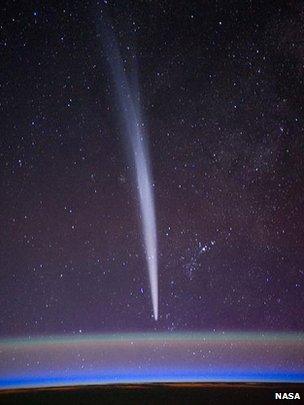Star of Bethlehem: The astronomical explanations
- Published

Some astronomers suggest the star was two bright objects 'in conjunction'
It might seem churlish to dissect such an enduring image of Christmas as the star of Bethlehem, but a quiet astronomical debate has been bubbling away for decades. Could some real cosmic event have drawn "three wise men" on a journey to find a newborn king?
This debate requires one very big assumption - that the story of the star and the journey is true.
Prof David Hughes, an astronomer from the University of Sheffield, first published a review of the theories on the famous star in the 1970s, external.
Having spent many years studying the astronomical explanations and reviewing the associated biblical stories, he is now an expert on the subject.
But there are some intriguing historical parallels.
The three kings were religious scholars known as the Magi - revered Babylonian astronomers and astrologists. They studied the stars and planets, interpreting the meaning behind cosmic events.
Anything very unusual was considered an omen, so the star must have been both rare and visually spectacular. And, says Hughes, it would have had a very clear message for the Magi.
This leads the astronomer to conclude that the star of Bethlehem was probably not a star at all, and that it was more than one single event.
"If you read the Bible carefully," says Hughes, "the Magi saw something when they were in their own country - [probably Babylon] - so they travelled to Jerusalem and had a word with King Herod."
According to the story, the Magi told Herod of the sign they had seen and, says Hughes, "when they left Jerusalem [for] Bethlehem, they saw something again".
Hughes's best explanation for this series of events is something known as a triple conjunction between Jupiter and Saturn - with the two planets coming close together in the sky three times over a short period.
"[This happens when] you get an alignment between the Sun, the Earth, Jupiter and Saturn," says Hughes.
Tim O'Brien, associate director of Jodrell Bank Observatory in Cheshire, suggests this would have looked striking. "It's remarkable how much your attention is drawn when two very bright objects come together in the sky," he explains.
And once the planets lined up in their orbits, Earth would "overtake" the others, meaning that Jupiter and Saturn would appear to change direction in the night sky.
"At that time, people would have set great store by the motions of the planets," says O'Brien.
Even more significantly, the event is believed to have been in the constellation Pisces, which represents one of the signs of the zodiac.
"You would [only] get a triple conjunction like this about every 900 years," he says, so for astronomers in Babylon 2,000 years ago, it would have been a signal of something very significant.
"A triple conjunction of this kind ticks all the boxes."
The second favoured explanation is a very bright comet.
While certainly spectacular and ethereal in appearance, comets are essentially "big, dirty snowballs" flying through space.
"When they come close to the Sun, this ice melts - solar wind blows this material out into space, so you get a tail of matter coming off the comet," explains O'Brien.

Comets can appear to "stand over" the horizon
This tail, which points away from the Sun, is one of the things that has made the comet idea popular, explains Hughes.
"Quite a few people have said that comets seem to 'stand over' the Earth, because of their coma and tail sometimes looking like an arrow," says Hughes.
The most timely record was of a bright comet appearing in the constellation of Capricorn in 5BC, which was recorded by astronomers in China.
A less likely, but more famous candidate was Halley's comet, which was visible around 12BC.
Those who favour this theory point out that the 5BC comet would have been in the southern sky as seen from Jerusalem, with the head of the comet close to the horizon and the tail is pointing vertically upward.
"Quite a lot of people liked the comet idea, so it crops up in quite a lot of Christmas cards," says Hughes.
"The snag is that they're not that rare. They were also commonly associated with the 'four Ds' - doom, death, disease and disaster," he suggests. "So if it did contain a message, it would have been a bad omen."
Another theory is that the star was light from the birth of a new star, or nova.
There are records - again from astronomers in the Far East - of a new star in the small, northern constellation of Aquila in 4BC.
Hughes says: "People who like this theory say this new star would have been [positioned] directly over Jerusalem."
Dr Robert Cockcroft, manager of the McCallion Planetarium at McMaster University in Ontario, external says a nova is "a good candidate" for the star of Bethlehem.

A new star, or nova, could have given the three wise men something to follow
"It can 'appear' as a new star in a constellation, and fade again over the following months," he explains.
"It is also not too bright, explaining why we don't have any records of it in the west." Cockcroft suggests that this might also have given the three wise men something to follow.
While other "omens" would have been needed to cause the Magi to set out on their journey west to Jerusalem, he says , it would take them months to get there, "by which time Aquila [and the new star could have] risen in the sky to appear in the south.
"Bethlehem lies due south of Jerusalem, so that Magi could 'follow' the star to Bethlehem."
Other more improbable but entertaining theories have been proposed over the years, says Hughes.
One he describes as particularly far-fetched was suggested in a 1979 academic paper by the Greek astronomer George Banos, external. He proposed that the Christmas star was actually the planet Uranus.
Banos suggested that the Magi discovered the planet 1,800 years before the astronomer William Herschel formally recorded the discovery in 1781.
"His idea was that the Magi discovered Uranus, that this was the star of Bethlehem and they then tried to hush up the discovery," Hughes explains.
Follow the Star will be broadcast on Sunday 23 December at 1900 GMT on BBC Radio 2